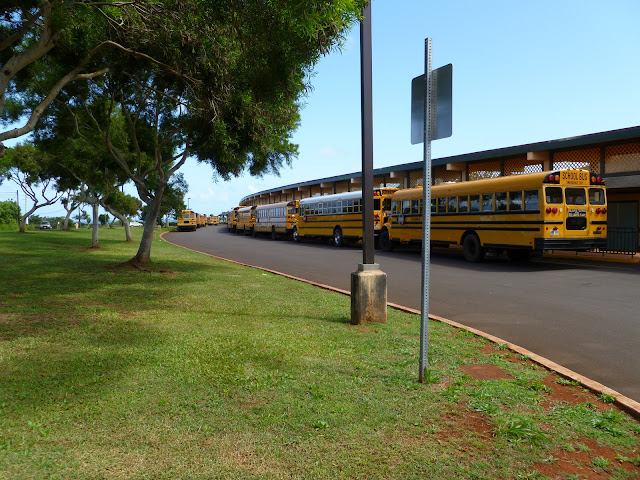In the aftermath of the worst earthquake to rock Japan and the ensuing tsunami devastation, we offer prayers and thoughts for the 1800+ victims (as of this writing) and their loved ones.
This post is produced to educate and share observations of interest with our readership and is by no means intended to exploit the Japanese crisis.
On Friday, March 11th, following an all clear signal from Kauai Civil Defense, my brother, Charlie, immediately drove to Kapaa town to specifically check out the action of the water within the Kapaa Canal as well as the adjacent vicinity where the canal merges with the Pacific Ocean.
Photo 3: A local fisherman prepares his gear.
Photo 4: Dirty water coming out from the canal appears to be wrapping itself around the left side of the jetty.
Photo 5: The current now appears to be going back in--i.e., upstream.
Photo 6: The ocean water is noticeably cleaner, not as brown as just moments before. This suggests that a stronger current is pushing the muddy water back upstream.
Photo 7: The dirty water is crossing the dredge where my brother, Charlie, goes diving for fish and octopi.
Photo 8: Homeless Jamaican sunbather oblivious to current global or local events. Having a peaceful nap!
Photo 9: In just a matter of a few minutes, the dirty water that had previously worked its way around the left side jetty has disappeared. Amazing! If you look carefully at the surface of the water, you can see what appears to be evidence of very strong current agitation, not unlike the action of a giant washing machine.
Photo 10: Here is a wild rooster, noticeably ailing or stressed by the environmental changes. It is scientifically documented that animals are super sensitive to such changes.
Photo 11: The water starts to recede again.
Photo 12: The water usually goes out during low tide. Here, it is coming in.
Photo 13: Once again, the water is receding.
Photo 14: Here, a tourist is swimming in what my brother, Charlie, referred to as lepto water. I Googled the term and learned that people who come into contact with fresh water and mud can contract a bacterial disease known as leptospirosis. Symptoms include high fever, headache, chills, muscle aches, conjunctivitis, diarrhea, vomiting, and kidney or liver problems.
Photo 15: Female tourist, perhaps self-conscious about someone filming her swimming in the bacteria-laden water, makes her departure from it.
Photo 16: It is highly unusual for all the Kapaa School buses to be parked in front of the Kapaa Middle School which is located on an elevated level. Usually, they are parked in Kapaa town at sea level. My brother found this noteworthy and sent this photo to me, yet another consequence of the tsunami warning on Kauai.
And now, for the conclusion to this post, here is a video of the unusual water activity in the canal. Charlie was on the bridge and used his cellphone to capture this footage.
This post is produced to educate and share observations of interest with our readership and is by no means intended to exploit the Japanese crisis.
On Friday, March 11th, following an all clear signal from Kauai Civil Defense, my brother, Charlie, immediately drove to Kapaa town to specifically check out the action of the water within the Kapaa Canal as well as the adjacent vicinity where the canal merges with the Pacific Ocean.
Photo 3: A local fisherman prepares his gear.
Photo 4: Dirty water coming out from the canal appears to be wrapping itself around the left side of the jetty.
Photo 5: The current now appears to be going back in--i.e., upstream.
Photo 6: The ocean water is noticeably cleaner, not as brown as just moments before. This suggests that a stronger current is pushing the muddy water back upstream.
Photo 7: The dirty water is crossing the dredge where my brother, Charlie, goes diving for fish and octopi.
Photo 8: Homeless Jamaican sunbather oblivious to current global or local events. Having a peaceful nap!
Photo 9: In just a matter of a few minutes, the dirty water that had previously worked its way around the left side jetty has disappeared. Amazing! If you look carefully at the surface of the water, you can see what appears to be evidence of very strong current agitation, not unlike the action of a giant washing machine.
Photo 10: Here is a wild rooster, noticeably ailing or stressed by the environmental changes. It is scientifically documented that animals are super sensitive to such changes.
Photo 11: The water starts to recede again.
Photo 12: The water usually goes out during low tide. Here, it is coming in.
Photo 13: Once again, the water is receding.
Photo 14: Here, a tourist is swimming in what my brother, Charlie, referred to as lepto water. I Googled the term and learned that people who come into contact with fresh water and mud can contract a bacterial disease known as leptospirosis. Symptoms include high fever, headache, chills, muscle aches, conjunctivitis, diarrhea, vomiting, and kidney or liver problems.
Photo 15: Female tourist, perhaps self-conscious about someone filming her swimming in the bacteria-laden water, makes her departure from it.
Photo 16: It is highly unusual for all the Kapaa School buses to be parked in front of the Kapaa Middle School which is located on an elevated level. Usually, they are parked in Kapaa town at sea level. My brother found this noteworthy and sent this photo to me, yet another consequence of the tsunami warning on Kauai.
And now, for the conclusion to this post, here is a video of the unusual water activity in the canal. Charlie was on the bridge and used his cellphone to capture this footage.
















No comments:
Post a Comment